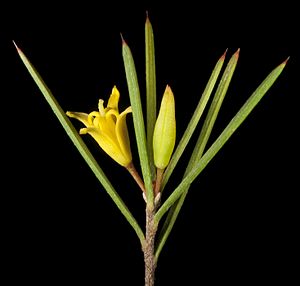Persoonia sulcata facts for kids
Quick facts for kids Persoonia sulcata |
|
|---|---|
 |
|
| Conservation status | |
| Scientific classification | |
| Genus: |
Persoonia
|
| Species: |
sulcata
|
| Synonyms | |
|
|
Persoonia sulcata is a special plant that belongs to the Proteaceae family. It is a type of shrub found only in the south-west part of Western Australia. This plant is usually a small bush that grows upright or spreads low to the ground. It has thin, long leaves and bright yellow flowers. These flowers grow either by themselves or in small groups where the leaves meet the stem. You can find Persoonia sulcata growing in forests or on rocky hillsides. It grows in different areas that are not connected to each other.
Contents
What Persoonia sulcata Looks Like
Persoonia sulcata is a shrub that can grow from 0.2 to 1 meter (about 0.7 to 3.3 feet) tall. It often has several stems or trunks. The bark on its trunks is smooth and grey.
Leaves and Flowers
The leaves of this plant grow one after another along the stem. They are long and thin, like a line. Most leaves are about 15 to 50 millimeters (0.6 to 2 inches) long and about 1 millimeter (0.04 inches) wide. They feel tough and leathery. Both sides of the leaf are the same color. You can easily see the main vein in the middle of the leaf. The leaves also have sharp tips and long grooves, like tiny furrows.
The flowers are yellow and grow either alone or in groups of up to three. They appear where the leaves meet the stem. Each flower sits on a smooth stalk, called a pedicel, which is 3 to 12 millimeters (0.1 to 0.5 inches) long.
Flower Parts
Each flower has four smooth, yellow parts called tepals. These tepals are like petals and sepals combined. They are 8 to 11 millimeters (0.3 to 0.4 inches) long. They are joined at the bottom, but their tips curl back. In the center of the flower is a style, which is part of the plant's reproductive system. Around the style are four yellow anthers. Anthers hold the pollen. They are attached to the tepals, and their tips also curl back. If you look at the flower from the end, the anthers look like a cross.
Persoonia sulcata flowers bloom from September to November. After flowering, the plant produces smooth, green fruits. These fruits are called drupes, which are fleshy fruits with a hard pit inside, like a peach or cherry.
Plant Names and History
The plant Persoonia sulcata was first officially described in 1856 by a scientist named Carl Meissner. He wrote about it in a book called Prodromus Systematis Naturalis Regni Vegetabilis.
Meaning of the Name
The second part of its name, sulcata, comes from a Latin word. It means "furrow" or "plow." This name likely refers to the long grooves or furrows found on the plant's leaves.
Where Persoonia sulcata Lives
This type of Persoonia plant grows in Eucalyptus woodlands. Sometimes, it can also be found on rocky hillsides. It lives in two main areas in Western Australia. One area is around New Norcia, Calingiri, and Mogumber. The other area is in John Forrest National Park. These two groups of plants are found in different natural regions of Western Australia.
Protecting Persoonia sulcata
The Government of Western Australia's Department of Parks and Wildlife has given Persoonia sulcata a special classification. It is listed as "Priority Four." This means the plant is rare or nearly threatened. It needs to be watched and protected to make sure it continues to survive in the wild.


